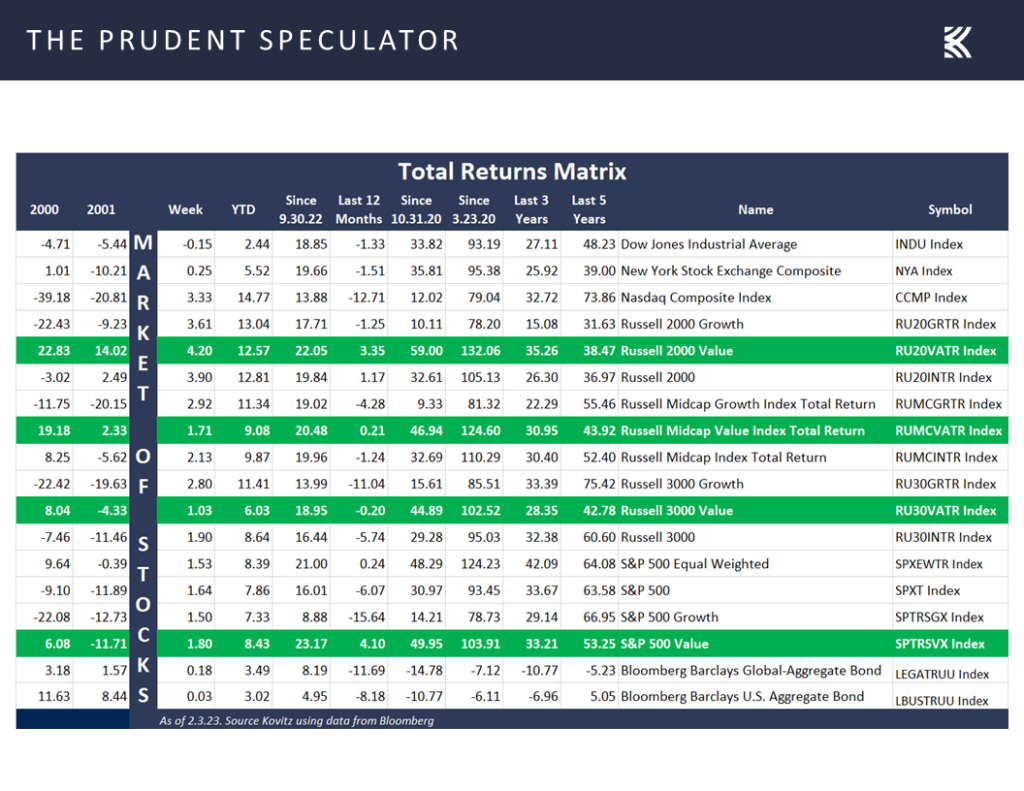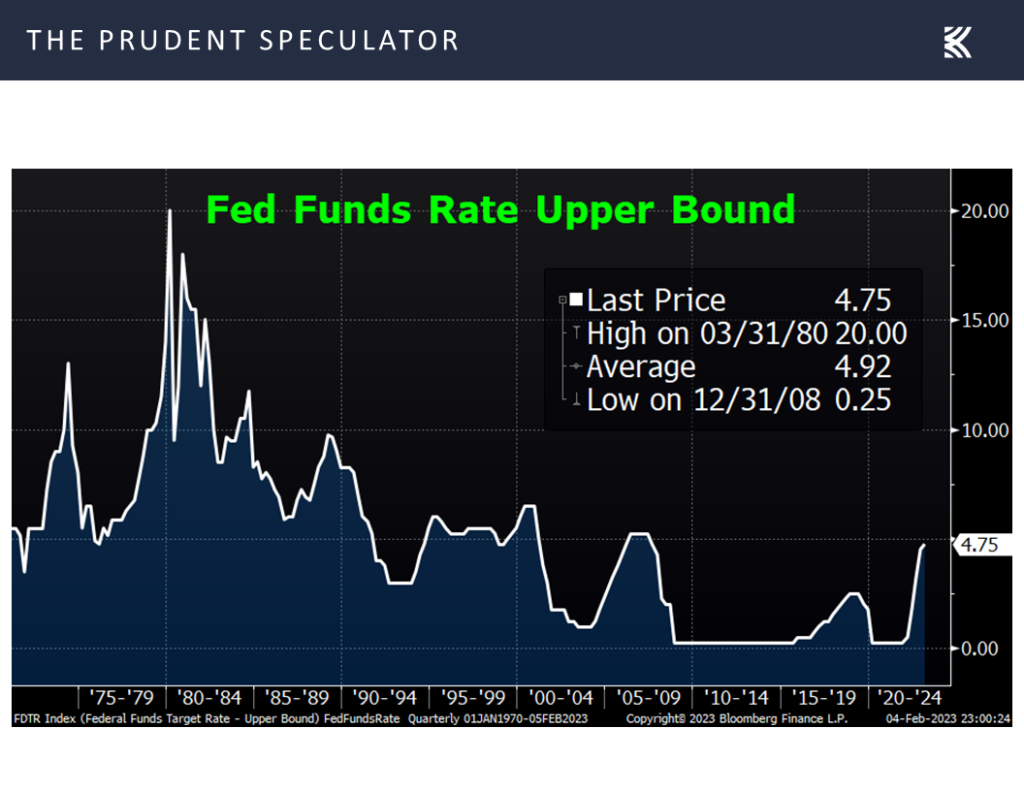The Prudent Speculator Weekly Commentary is expertly curated every week as a valuable resource for stock market news, investing tips, business insights, and economic trends as it relates to value stock investing. This week, we cover the recent Federal Reserve meeting and 25 bps rate fed hike, the economic outlook, corporate profits and more. We also include a short preview of our specific stock picks for the week; the entire list is available only to our community of loyal subscribers.
| Subscribe to The Prudent Speculator |
Executive Summary
- Week in Review
- The Fed: 25-Basis-Point Rate Hike; Historical Equity Returns & Tightening
- Econ Numbers: Mixed Picture But Blowout Jobs Report
- Econ Outlook: IMF Raises Forecast
- Recessions: No Reason, On Average, to Sell Stocks
- Corporate Profits: Q4 Report Cards OK Thus Far
- Valuations: Inexpensive Metrics for our Portfolios
- Sentiment: AAII Still Bearish
- Stock News & Earnings: Updates on 15 stocks across six sectors
Week in Review
It is always fascinating to listen to the so-called experts explain the short-term gyrations of the equity markets. For example, stocks began the latest trading week with a sizable setback on Monday, prompting one pundit to state, “The market has had a flying couple of weeks. But as we get closer to the Fed meeting, cautiousness is certainly going to creep in.”
Another proclaimed, “The reality is that earnings are proving to be even worse than feared based on the data, especially as it relates to margins. Investors seem to have forgotten the cardinal rule of ‘Don’t Fight the Fed.’ Perhaps this week will serve as a reminder.”
The “certain” cautiousness and “cardinal rule” did not exactly play out as expected over the ensuing four days. Indeed, the S&P 500 jumped 2.95%, helping to propel the popular index to its fourth winning week out of five this year, and pushing several of the Value benchmarks into Bull Market territory since the end-of-Q3 lows.

The Fed: 25-Basis-Point Rate Fed Hike; Historical Equity Returns & Tightening
Obviously, short-term fluctuations don’t mean much in the overall scheme of things, but The Wall Street Journal on Thursday ran the “shocking” headline, “Stocks Climb After Fed Rate Hike,” as Jerome H. Powell & Co. lifted the upper end of the target for the Fed Funds rate by another 25 basis points to 4.75%.

We put “shocking” in quotations as many think the Federal Reserve hiking the Fed Funds rate is a big headwind for equities. However, seven decades of returns data show that stocks in general have performed well on average, both concurrent with and subsequent to increases (as well as decreases) in the Fed Funds rate over 3-, 6-, and 12-month time spans, with Value Stocks leading the charge no matter the direction.

The FOMC Statement that accompanied the decision on interest rates included:
Recent indicators point to modest growth in spending and production. Job gains have been robust in recent months, and the unemployment rate has remained low. Inflation has eased somewhat but remains elevated.
In determining the extent of future increases in the target range, the Committee will take into account the cumulative tightening of monetary policy, the lags with which monetary policy affects economic activity and inflation, and economic and financial developments.
And Chair Powell had this to say in the opening remarks of his press conference that followed the release of the Statement:
My colleagues and I understand the hardship that high inflation is causing, and we are strongly committed to bringing inflation back down to our 2 percent goal. Over the past year, we have taken forceful actions to tighten the stance of monetary policy. We have covered a lot of ground, and the full effects of our rapid tightening so far are yet to be felt. Even so, we have more work to do. Price stability is the responsibility of the Federal Reserve and serves as the bedrock of our economy. Without price stability, the economy does not work for anyone. In particular, without price stability, we will not achieve a sustained period of labor market conditions that benefit all.
Today, the FOMC raised our policy interest rate by 25 basis points. We continue to anticipate that ongoing increases will be appropriate in order to attain a stance of monetary policy that is sufficiently restrictive to return inflation to 2 percent over time. In addition, we are continuing the process of significantly reducing the size of our balance sheet. Restoring price stability will likely require maintaining a restrictive stance for some time.
There always are plenty of other factors that influence stock prices, but the fact that stocks moved up on the Fed news had market watchers seemingly deciding for the moment that the Fed might be closer to the end of the rate-hiking cycle than previously thought. After all, Chair Powell went on to say:
We are seeing the effects of our policy actions on demand in the most interest-sensitive sectors of the economy, particularly housing. It will take time, however, for the full effects of monetary restraint to be realized, especially on inflation. In light of the cumulative tightening of monetary policy and the lags with which monetary policy affects economic activity and inflation, the Committee decided to raise interest rates by 25 basis points today, continuing the step down from last year’s rapid pace of increases. Shifting to a slower pace will better allow the Committee to assess the economy’s progress toward our goals as we determine the extent of future increases that will be required to attain a sufficiently restrictive stance. We will continue to make our decisions meeting by meeting, taking into account the totality of incoming data and their implications for the outlook for economic activity and inflation.
Of course, one prominent economist cited in The Wall Street Journal offered, “Markets rallied fiercely despite the hawkish message because investors know the Fed isn’t omniscient nor is it dogmatic.” Not quite sure that we heard a hawkish tone as the Chair confirmed, “We can now say for the first tome the disinflationary process has started,” but it is good to know that investors now realize that the Fed does not have a crystal ball!
Econ Numbers – Mixed Picture But Blowout Jobs Report
When it comes to the Fed, about the only thing we can say for sure is that we agree with the Powell statement, “We will continue to make our decisions meeting by meeting, taking into account the totality of incoming data and their implications for the outlook for economic activity and inflation.”
And that incoming data was relatively weak for much of last week, at least as far as the health of the economy is concerned. Consumer confidence, per data from the Conference Board, pulled back to a reading of 107.1 in January, down from 109.0 in December and below expectations of 109.5. Still, the measure is above the average dating back to the 1980s. For its part, the Chicago Business Barometer, also known as the regional manufacturing PMI, fell to a worse-than-expected 44.3 in January, down from 45.1 in December and well below its historical average.

As noted above and below, both Consumer Confidence and the Chicago Business Barometer fell in January.


Note the ISM PMI Drop; now suggesting a 0.5% contraction in real GDP on an annualized basis.
On the other side of the coin, Friday brought a series of positive economic statistics. The latest read on the health of the service sector soared to 55.2 in January, up sharply from December’s figure of 49.6. The number was much better than expected and was slightly above average, suggesting a solid non-manufacturing economy. The Institute for Supply Management stated, “The past relationship between the Services PMI and the overall economy…corresponds to a 1.8% increase in real gross domestic product (GDP) on an annualized basis.”

Note the ISM NMI Jump; now suggesting a 1.8% increase in real GDP on an annualized basis.
Even better, for those who prefer a strong economy, the all-important monthly labor report blew away expectations.
Economists were looking for a gain of 187,000 payrolls, so the increase of 517,000 in January shattered projections, while there were an additional 304,000 jobs created in the second half of 2022 than previously estimated. Notable job gains were in in hospitality, health care and white-collar professional businesses. While the labor market remains very healthy, wage gains pulled back on a year-over-year basis, rising 4.4% in January, down from a 4.6% increase the month prior, and potentially cheering those worried about inflation.

The January Jobs numbers were incredibly robust, but wage pressure continued to lessen.


The Fed Fund futures became more hawkish last week, projecting a peak in the rate at more than 5% this summer.
Econ Outlook – IMF Raises Forecast
No doubt, there is still plenty of uncertainty about the economic outlook but when is there ever certainty? Interestingly, Bloomberg continues to calculate a 65% chance of recession in the next 12 months…

…even as the International Monetary Fund (IMF) just raised its forecast for global and U.S. GDP growth.

The IMF stated:
Global growth, estimated at 3.4 percent in 2022, is projected to fall to 2.9 percent in 2023 before rising to 3.1 percent in 2024 (Table 1). Compared with the October forecast, the estimate for 2022 and the forecast for 2023 are both higher by about 0.2 percentage point, reflecting positive surprises and greater-than-expected resilience in numerous economies. Negative growth in global GDP or global GDP per capita—which often happens when there is a global recession—is not expected. Nevertheless, global growth projected for 2023 and 2024 is below the historical (2000–19) annual average of 3.8 percent.
The forecast of low growth in 2023 reflects the rise in central bank rates to fight inflation––especially in advanced economies––as well as the war in Ukraine. The decline in growth in 2023 from 2022 is driven by advanced economies; in emerging market and developing economies, growth is estimated to have bottomed out in 2022. Growth is expected to pick up in China with the full reopening in 2023. The expected pickup in 2024 in both groups of economies reflects gradual recovery from the effects of the war in Ukraine and subsiding inflation. Following the path of global demand, world trade growth is expected to decline in 2023 to 2.4 percent, despite an easing of supply bottlenecks, before rising to 3.4 percent in 2024.
In the United States, growth is projected to fall from 2.0 percent in 2022 to 1.4 percent in 2023 and 1.0 percent in 2024. With growth rebounding in the second half of 2024, growth in 2024 will be faster than in 2023 on a fourth-quarter-over-fourth-quarter basis, as in most advanced economies. There is a 0.4 percentage point upward revision for annual growth in 2023, reflecting carryover effects from domestic demand resilience in 2022, but a 0.2 percentage point downward revision of growth in 2024 due to the steeper path of Federal Reserve rate hikes, to a peak of about 5.1 percent in 2023.
Recessions – No Reason, On Average, to Sell Stocks
The IMF may be overly optimistic, but as the saying goes, the stock market (and economists) has predicted nine of the last five recessions. And the 15 prior instances of actual negative real economic growth illustrate that long-term-oriented investors (on average) should stay invested (in Value, preferably) no matter what.

There is much hand-wringing over a “hard” or “soft” landing, but the historical evidence shows that even if the U.S. economy officially enters a recession, long-term-oriented investors should stick with stocks.
Corporate Profits – Q4 Report Cards OK Thus Far
Further, we believe that even a mild recession would not put a big dent in corporate profits. We are now about half-way through fourth quarter earnings season and despite those who argue that results have been disappointing, the numbers have been OK, even as outlooks continued to be subdued and stock prices sometimes have reacted negatively. For the S&P 500, 69.8% of companies have beat EPS expectations and 52.0% have exceeded revenue forecasts, while present projections call for decent growth this year.
 |
 |
Certainly, we realize that analysts are often overly optimistic in their earnings outlooks, but Q4 2022 results have been solid thus far and the outlook for 2023 is still for significantly higher EPS.
Valuations – Inexpensive Metrics for our Portfolios
Not surprisingly, we remain optimistic about the long-term prospects of our broadly diversified portfolios of what we believe to be undervalued stocks.

We sleep very well at night, given the inexpensive valuation multiples and generous dividend yields associated with our managed account portfolios.
That does not mean that we expect the recent run northward to continue without interruption, as we know that selloffs, downturns, pullbacks, corrections and even Bear Markets are events that equity investors always have had to endure on their way to the best long-term performance of any of the financial asset classes.

The secret to success in stocks is not to get scared out of them as every downturn has been followed by an upswing of far greater magnitude, so much so that long-term returns for Value stocks have exceeded 13% per annum.
We are always braced for downside volatility and we note that the equity futures are suggesting the new trading week will begin on a sour note, with the China Spy Balloon drama the latest news to spook investors. However, we remember what Warren Buffett said during the depths of the Great Financial Crisis (GFC) back in 2008:
Over the long term, the stock market news will be good. In the 20th century, the United States endured two world wars and other traumatic and expensive military conflicts; the Depression; a dozen or so recessions and financial panics; oil shocks; a flu epidemic; and the resignation of a disgraced president. Yet the Dow rose from 66 to 11,497.
And we can say the same so far in the 21st century. Even with 9/11, the GFC and plenty of disconcerting events since that terrible GFC Bear Market ended on March 9, 2009, those who remember that time in the market trumps market timing have been handsomely rewarded as the Dow stands at nearly 34,000 today.

There have been numerous frightening events over the years, but equities in the fullness of time have overcome all setbacks.
Sentiment – AAII Still Bearish
Happily, for those of us with a contrarian bent, there is still plenty of fear on Main Street, given that the latest AAII Bull-Bear Sentiment Survey still shows more of the latter, when the historical norm is for the optimists to outweigh the pessimists by seven full percentage points.

Certainly, we realize that analysts are often overly optimistic in their earnings outlooks, but Q4 2022 results have been solid thus far and the outlook for 2023 is still for significantly higher EPS.

The good folks in the AAII Sentiment Survey are still pessimistic, which is not a bad thing based on 36 years of equity returns data for this contrarian gauge.
Stock News & Earnings – Updates on 15 stocks across six sectors
Jason Clark, Chris Quigley and Zack Tart take a look at earnings reports and other market-moving news of note out last week for several of our recommendations.



